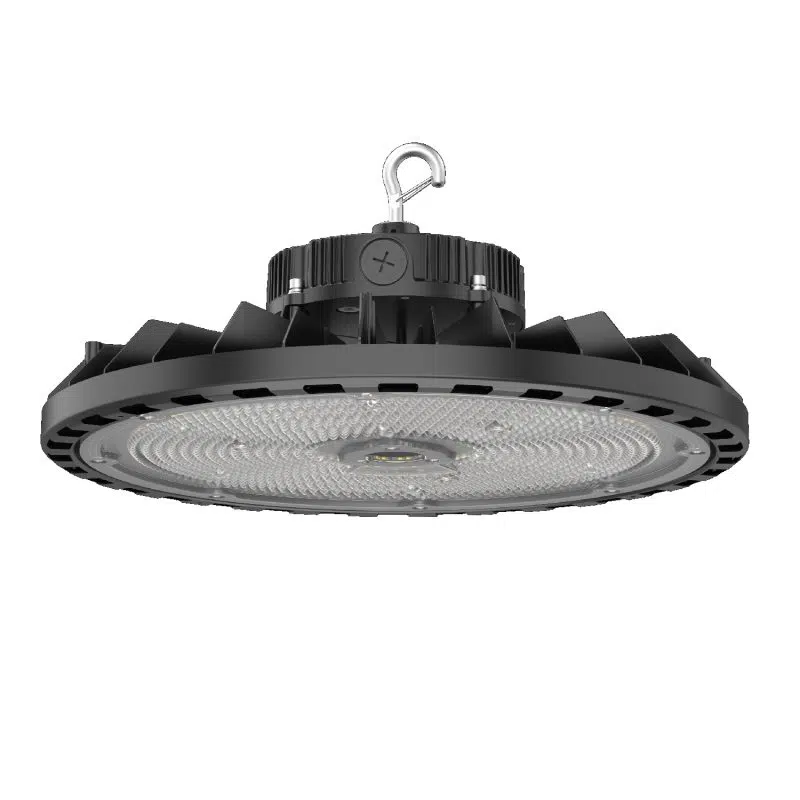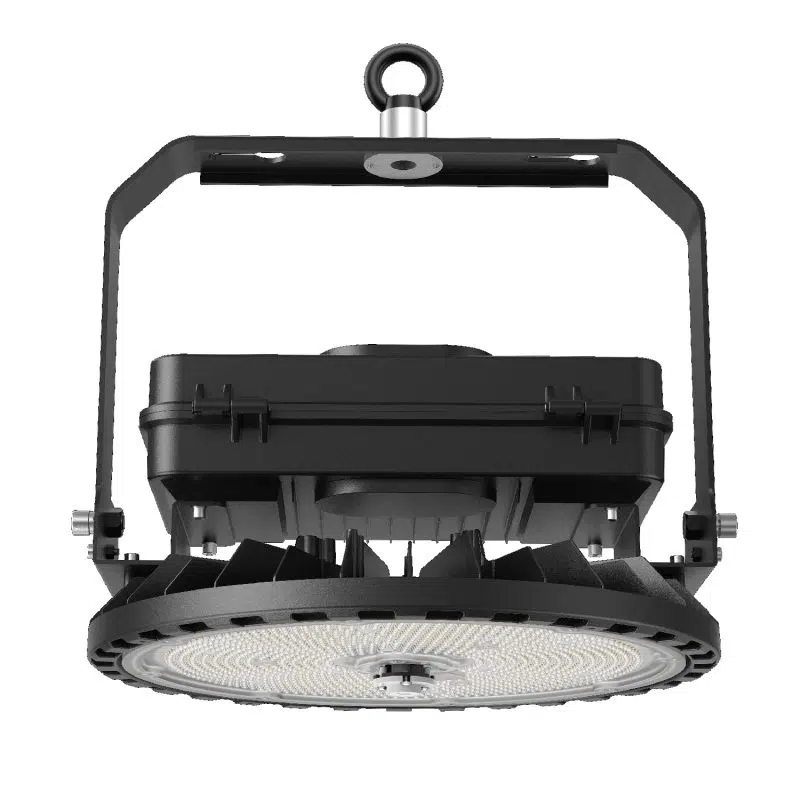Showing 1–30 of 45 results
- SKU:MLLG-LED-HB3-200-50-120-[C] | Web ID:1952Black:1877 In StockShips 2-3 DaysWhite:267 In StockShips 2-3 Days
- Watts: 100 | 120 | 150 | 200
- Lumens: 14000 | 16800 | 21000 | 28000
- Lumens/Watt: 140
- Replaces: 250 | 400 Watt Metal Halide
- Color Temp: 5000K
- CRI: 80+
- IP Rating: IP65
- IK Rating: IK08
- Voltage: 100V-277V
- Surge Protection: 4kV
- Operating Temp: -22°F to 122°F (-30°C to 50°C)
- Rated Life: 170,000 (L70) hours
- Dimmable: 1-10V
- Beam Angle (Std): 120°
- Optics: Polycarbonate Lens
- Fixture Color: Black | White
- Mount: Eye-Hook (std) | Pendant
- Dimensions: 11.02 X 7.72 Inches
- Cord Length: 5 Feet
- Weight: 5.5 lbs
Starting At$99.72
- SKU:MLLG-LED-HB3-100-50-120 | Web ID:2024Availability:161 In StockShips 2-3 Days
- Watts: 60 | 80 | 100
- Lumens: 8400 | 11200 | 14000
- Lumens/Watt: 140
- Replaces: 150 | 250 Watt Metal Halide
- Color Temp: 5000K
- CRI: 80+
- IP Rating: IP65
- IK Rating: IK08
- Voltage: 100V-277V
- Surge Protection: 4kV
- Operating Temp: -22°F to 122°F (-30°C to 50°C)
- Rated Life: 170,000 (L70) hours
- Dimmable: 1-10V
- Beam Angle (Std): 120°
- Optics: Polycarbonate Lens
- Fixture Color: Black
- Mount: Eye-Hook (std) | Pendant
- Dimensions: 9.2 X 7.1 Inches
- Cord Length: 5 Feet
- Weight: 3.5 lbs
Starting At$82.99
- SKU:LLS-HB-200A-CC-[C] | Web ID:2574Black:1535 In StockShips 2-3 DaysWhite:969 In StockShips 2-3 Days
- Watts: 120 | 160 | 200
- Lumens: 19800 | 26400 | 33000
- Lumens/Watt: 165
- Replaces: 250 | 400 Watt Metal Halide
- Color Temp: 4000K | 5000K
- CRI: 80+
- IP Rating: IP65
- IK Rating: IK08
- Voltage: 100V-277V
- Surge Protection: 6kV
- Operating Temp: -22°F to 122°F (-30°C to 50°C)
- Rated Life: 134,000 (L70) hours
- Dimmable: 1-10V
- Beam Angle (Std): 120°
- Optics: Polycarbonate Lens
- Fixture Color: Black | White
- Mount: Eye-Hook (std) | Pendant | Surface
- Dimensions: 11.8 X 6.6 Inches
- Weight: 5.1 lbs
Starting At$106.21
- SKU:MLLG-LED-HBHO-150-5-120 | Web ID:1527Availability:22 In StockShips 2-3 Days
- Watts: 80 | 100 | 120 | 150
- Lumens: 16000 | 20000 | 24000 | 30000
- Lumens/Watt: 200
- Replaces: 400 Watt Metal Halide
- Color Temp: 5000K
- CRI: 80+
- IP Rating: IP65
- IK Rating: IK08
- Voltage: 100V-277V
- Surge Protection: 4kV
- Operating Temp: -22°F to 122°F (-30°C to 50°C)
- Rated Life: 134,000 (L70) hours
- Dimmable: 1-10V
- Beam Angle (Std): 120°
- Beam Angle (Opt): 60° | 90°
- Optics: Polycarbonate Lens
- Fixture Color: Black
- Mount: Eye-Hook (std) | Pendant | Surface
- Dimensions: 14.7 X 7.32 Inches
- Cord Length: 5 Feet
- Weight: 12 lbs
Starting At$149.36
- SKU:MLLG-LED-HBHO-240-5-120 | Web ID:1528Availability:257 In StockShips 2-3 Days
- Watts: 150 | 175 | 200 | 240
- Lumens: 28500 | 33250 | 38000 | 45600
- Lumens/Watt: 190
- Replaces: 1000 Watt Metal Halide
- Color Temp: 4000K | 5000K
- CRI: 80+
- IP Rating: IP65
- IK Rating: IK08
- Voltage: 100V-277V
- Surge Protection: 4kV
- Operating Temp: -22°F to 122°F (-30°C to 50°C)
- Rated Life: 134,000 (L70) hours
- Dimmable: 1-10V
- Beam Angle (Std): 120°
- Beam Angle (Opt): 60° | 90°
- Optics: Polycarbonate Lens
- Fixture Color: Black
- Mount: Eye-Hook (std) | Pendant | Surface
- Dimensions: 14.7 X 7.32 Inches
- Cord Length: 5 Feet
- Weight: 12 lbs
Starting At$188.82
- SKU:MLLG-AG-LED-HB-300-5-120-[V] | Web ID:980100V-277V:197 In StockShips 2-3 Days277V-480V:269 In StockShips 2-3 Days
- Watts: 300
- Lumens: 45000
- Lumens/Watt: 150
- Replaces: 1000 Watt Metal Halide
- Color Temp: 4000K | 5000K
- CRI: 70+
- IP Rating: IP65
- IK Rating: IK08
- Voltage: 100V-277V | 277V-480V | 127-300VDC
- Operating Temp: -22°F to 140°F
- Rated Life: 164,000 (L70) hours
- Dimmable: 1-10V
- Beam Angle (Std): 120°
- Optics: Tempered Glass Lens
- Fixture Color: Black
- Mount: Eye-Hook (std) | Pendant | Surface
- Dimensions: 16 X 8 Inches
- Cord Length: 5 Feet
- Weight: 21 lbs
Starting At$385.25
- SKU:LLS-X-HB8-150/120/100-CC | Web ID:2188Availability:994 In StockShips 3-5 Days
- Watts: 100 | 120 | 150
- Lumens: 15000 | 18000 | 22500
- Lumens/Watt: 150
- Replaces: 250 | 400 Watt Metal Halide
- Color Temp: 4000K | 5000K
- CRI: 80+
- IP Rating: IP65
- IK Rating: IK10
- Voltage: 100V-277V
- Surge Protection: 4kV
- Operating Temp: -40°F to 113°F (-40°C to 45°C)
- Rated Life: 50,000 (L70) hours
- Dimmable: 0-10V
- Beam Angle (Std): 120°
- Optics: Polycarbonate Lens
- Fixture Color: Black
- Mount: Eye-Hook (std) | Surface
- Dimensions: 11.6 X 8 Inches
- Cord Length: 5 Feet
- Weight: 4.5 lbs
Starting At$132.69
- SKU:LLS-X-HB8-240/200/180-CC | Web ID:2189Availability:1131 In StockShips 2-3 Days
- Watts: 180 | 200 | 240
- Lumens: 27000 | 30000 | 36000
- Lumens/Watt: 150
- Replaces: 400 | 1000 Watt Metal Halide
- Color Temp: 4000K | 5000K
- CRI: 80+
- IP Rating: IP65
- IK Rating: IK10
- Voltage: 100V-277V
- Surge Protection: 4kV
- Operating Temp: -40°F to 113°F (-40°C to 45°C)
- Rated Life: 50,000 (L70) hours
- Dimmable: 0-10V
- Beam Angle (Std): 120°
- Optics: Polycarbonate Lens
- Fixture Color: Black
- Mount: Eye-Hook (std) | Surface
- Dimensions: 12.8 X 8 Inches
- Cord Length: 5 Feet
- Weight: 6 lbs
Starting At$157.31
- SKU:LLS-X-HB9-240A-CC-[C] | Web ID:2564White:951 In StockShips 2-3 DaysBlack:1696 In StockShips 3-5 Days
- Watts: 150 | 200 | 240
- Lumens: 22500 | 30000 | 36000
- Lumens/Watt: 150
- Replaces: 400 | 1000 Watt Metal Halide
- Color Temp: 4000K | 5000K
- CRI: 80+
- IP Rating: IP65
- IK Rating: IK10
- Voltage: 100V-277V
- Surge Protection: 6kV
- Operating Temp: -40°F to 122°F (-40°C to 50°C)
- Rated Life: 50,000 (L70) hours
- Dimmable: 0-10V
- Beam Angle (Std): 120°
- Optics: Polycarbonate Lens
- Fixture Color: Black | White
- Mount: Eye-Hook (std) | Pendant | Surface
- Dimensions: 12 X 7.8 Inches
- Cord Length: 5 Feet
- Weight: 7.5 lbs
Starting At$143.40
- SKU:LLS-X-HB9-320A-CC-[C] | Web ID:2594Black:609 In StockShips 3-5 DaysWhite:13 In StockOut of Stock
- Watts: 200 | 240 | 320
- Lumens: 30000 | 36000 | 48000
- Lumens/Watt: 150
- Replaces: 1000 Watt Metal Halide
- Color Temp: 4000K | 5000K
- CRI: 80+
- IP Rating: IP65
- IK Rating: IK10
- Voltage: 100V-277V
- Surge Protection: 6kV
- Operating Temp: -40°F to 122°F (-40°C to 50°C)
- Rated Life: 50,000 (L70) hours
- Dimmable: 0-10V
- Beam Angle (Std): 110°
- Optics: Polycarbonate Lens
- Fixture Color: Black | White
- Mount: Eye-Hook (std) | Pendant | Surface
- Dimensions: 13.8 X 9.5 Inches
- Cord Length: 5 Feet
- Weight: 13 lbs
Starting At$197.85
- SKU:LLS-X-HB8-310/270/240-CC | Web ID:2211Availability:983 In StockShips 3-5 Days
- Watts: 240 | 270 | 310
- Lumens: 34800 | 39150 | 45000
- Lumens/Watt: 145
- Replaces: 400 | 1000 Watt Metal Halide
- Color Temp: 4000K | 5000K
- CRI: 80+
- IP Rating: IP65
- IK Rating: IK10
- Voltage: 100V-277V
- Surge Protection: 4kV
- Operating Temp: -40°F to 113°F (-40°C to 45°C)
- Rated Life: 50,000 (L70) hours
- Dimmable: 0-10V
- Beam Angle (Std): 110°
- Optics: Polycarbonate Lens
- Fixture Color: Black
- Mount: Eye-Hook (std) | Pendant | Surface
- Dimensions: 14 x 11 Inches
- Cord Length: 5 Feet
- Weight: 11 lbs
Starting At$193.64
- SKU:LLS-X-HB8-150-5-HV | Web ID:2187Availability:348 In StockShips 3-5 Days
- Watts: 150
- Lumens: 21700
- Lumens/Watt: 145
- Replaces: 400 | 1000 Watt Metal Halide
- Color Temp: 5000K
- CRI: 80+
- IP Rating: IP65
- IK Rating: IK10
- Voltage: 277V-480V
- Surge Protection: 4kV
- Operating Temp: -40°F to 113°F (-40°C to 45°C)
- Rated Life: 50,000 (L70) hours
- Dimmable: 0-10V
- Beam Angle (Std): 120°
- Optics: Polycarbonate Lens
- Fixture Color: Black
- Mount: Eye-Hook (std) | Surface
- Dimensions: 11.6 X 8.5 Inches
- Cord Length: 5 Feet
- Weight: 10 lbs
Starting At$180.00
- SKU:LLS-X-HB8-240-5-HV | Web ID:2213Availability:18 In StockShips 3-5 Days
- Watts: 240
- Lumens: 36000
- Lumens/Watt: 150
- Replaces: 1000 Watt Metal Halide
- Color Temp: 5000K
- CRI: 80+
- IP Rating: IP65
- IK Rating: IK10
- Voltage: 277V-480V
- Surge Protection: 4kV
- Operating Temp: -40°F to 113°F (-40°C to 45°C)
- Rated Life: 50,000 (L70) hours
- Dimmable: 0-10V
- Beam Angle (Std): 120°
- Optics: Polycarbonate Lens
- Fixture Color: Black
- Mount: Eye-Hook (std) | Pendant | Surface
- Dimensions: 12.8 X 9.1 Inches
- Cord Length: 5 Feet
- Weight: 8 lbs
Starting At$224.42
- SKU:LLS-X-HB8-310-5-HV | Web ID:2214Availability:451 In StockShips 3-5 Days
- Watts: 310
- Lumens: 45000
- Lumens/Watt: 145
- Replaces: 1000 | 1500 Watt Metal Halide
- Color Temp: 5000K
- CRI: 80+
- IP Rating: IP65
- IK Rating: IK10
- Voltage: 277V-480V
- Surge Protection: 4kV
- Operating Temp: -40°F to 113°F (-40°C to 45°C)
- Rated Life: 50,000 (L70) hours
- Dimmable: 0-10V
- Beam Angle (Std): 120°
- Optics: Polycarbonate Lens
- Fixture Color: Black
- Mount: Eye-Hook (std) | Pendant | Surface
- Dimensions: 13.8 X 10.9 Inches
- Cord Length: 5 Feet
- Weight: 13 lbs
Starting At$252.50
- SKU:MLLG-LED-HB5-480-5-60-[C] | Web ID:2025100V-277V:96 In StockShips 2-3 Days277V-480V:Built to Order 6 Weeks
- Watts: 480
- Lumens: 76800
- Lumens/Watt: 160
- Replaces: 1500 Watt Metal Halide
- Color Temp: 5000K
- CRI: 70+
- IP Rating: IP66
- IK Rating: IK08
- Voltage: 100V-277V | 277V-480V
- Surge Protection: 4kV
- Operating Temp: -22°F to 122°F 120-277V | -22°F to 113°F 277-480V
- Rated Life: 244,000 (L70) hours
- Dimmable: 1-10V
- Beam Angle (Std): 60°
- Beam Angle (Opt): 10° | 30°
- Optics: Polycarbonate Lens
- Fixture Color: Black
- Mount: Eye-Hook (std)
- Dimensions: 17.7 X 9.5 Inches
- Cord Length: 5 Feet
- Weight: 24 lbs
Starting At$432.70
- SKU:MLLG-LED-HB5-600-5-60-[V] | Web ID:2027100V-277V:72 In StockShips 2-3 Days277V-480V:Ships 2-3 Days
- Watts: 600
- Lumens: 96000
- Lumens/Watt: 160
- Replaces: 2000 Watt Metal Halide
- Color Temp: 5000K
- CRI: 70+
- IP Rating: IP66
- IK Rating: IK08
- Voltage: 100V-277V | 277V-480V
- Surge Protection: 6kV
- Operating Temp: -22°F to 113°F (-30°C to 45°C)
- Rated Life: 244,000 (L70) hours
- Dimmable: 1-10V
- Beam Angle (Std): 60°
- Beam Angle (Opt): 10° | 30°
- Optics: Polycarbonate Lens
- Fixture Color: Black
- Mount: Eye-Hook (std)
- Dimensions: 17.7 X 10.2 Inches
- Cord Length: 5 Feet
- Weight: 28.4 lbs
Starting At$595.18
- SKU:LLS-HB-500A-CC | Web ID:2663Back in Stock 12/15
- Watts: 300 | 400 | 500
- Lumens: 44900 | 62000 | 79100
- Lumens/Watt: 155
- Replaces: 1500 | 2000 Watt Metal Halide
- Color Temp: 4000K | 5000K
- CRI: 80+
- IP Rating: IP65
- IK Rating: IK08
- Voltage: 100V-277V
- Surge Protection: 6kV
- Operating Temp: -22°F to 122°F (-30°C to 50°C)
- Rated Life: 170,000 (L70) hours
- Dimmable: 0-10V
- Beam Angle (Std): 90°
- Optics: Polycarbonate Lens
- Fixture Color: Black
- Mount: Eye-Hook (std)
- Dimensions: 17.7 D x 10.6 H
- Weight: 14.5 lbs
Starting At$417.84
- SKU:LLS-HB-500A-CC-HV | Web ID:2664Back in Stock 12/15
- Watts: 250 | 375 | 500
- Lumens: 38700 | 58000 | 76800
- Lumens/Watt: 155
- Replaces: 1500 | 2000 Watt Metal Halide
- Color Temp: 4000K | 5000K
- CRI: 80+
- IP Rating: IP65
- IK Rating: IK08
- Voltage: 277V-480V
- Surge Protection: 10kV
- Operating Temp: -22°F to 122°F (-30°C to 50°C)
- Rated Life: 150,000 (L70) hours
- Dimmable: 0-10V
- Beam Angle (Std): 90°
- Optics: Polycarbonate Lens
- Fixture Color: Black
- Mount: Eye-Hook (std)
- Dimensions: 19 D x 17 H
- Weight: 28 lbs
Starting At$516.44
- SKU:MLLG-LE-LED-HB2-150-50-120-[V] | Web ID:1761100V-277V:898 In StockShips 3-5 Days277V-480V:582 In StockShips 3-5 Days
- Watts: 150
- Lumens: 24000
- Lumens/Watt: 160
- Replaces: 400 Watt Metal Halide
- Color Temp: 5000K
- CRI: 80+
- IP Rating: IP65
- IK Rating: IK08
- Voltage: 100V-277V | 277V-480V
- Operating Temp: -22°F to 122°F (-30°C to 50°C)
- Rated Life: 50,000 (L70) hours
- Dimmable: 1-10V
- Beam Angle (Std): 120°
- Optics: Polycarbonate Lens
- Fixture Color: Black
- Mount: Eye-Hook (std)
- Dimensions: 15.75 X 7.9 Inches
- Cord Length: 4 Feet
- Weight: 14.4 lbs
Starting At$130.00
- SKU:MLLG-LE-LED-HB2-200-50-120-[V] | Web ID:1859100V-277V:544 In StockShips 3-5 Days277V-480V:Out of Stock
- Watts: 200
- Lumens: 32000
- Lumens/Watt: 160
- Replaces: 400 Watt Metal Halide
- Color Temp: 5000K
- CRI: 80+
- IP Rating: IP65
- IK Rating: IK08
- Voltage: 100V-277V | 277V-480V
- Operating Temp: -22°F to 122°F (-30°C to 50°C)
- Rated Life: 50,000 (L70) hours
- Dimmable: 1-10V
- Beam Angle (Std): 120°
- Fixture Color: Black
- Mount: Eye-Hook (std)
- Dimensions: 15.75 in X 7.9 Inches
- Cord Length: 4 Feet
- Weight: 14.4 lbs
Starting At$166.00
- SKU:MLLG-LE-LED-HB2-240-50-120-[V] | Web ID:1744100V-277V:1332 In StockShips 3-5 Days277V-480V:1215 In StockShips 3-5 Days
- Watts: 240
- Lumens: 38400
- Lumens/Watt: 160
- Replaces: 1000 Watt Metal Halide
- Color Temp: 5000K
- CRI: 80+
- IP Rating: IP65
- Voltage: 100V-277V | 277V-480V
- Operating Temp: -22°F to 122°F (-30°C to 50°C)
- Rated Life: 50,000 (L70) hours
- Dimmable: 1-10V
- Beam Angle (Std): 120°
- Fixture Color: Black
- Mount: Eye-Hook (std)
- Dimensions: 15.75 X 7.9 Inches
- Cord Length: 4 Feet
- Weight: 14.4 lbs
Starting At$190.38
- SKU:LLS-AL-HB2A-200/240/300-CC-V2 | Web ID:2596Availability:7325 In StockShips 2-3 Days
- Watts: 200 | 240 | 300
- Lumens: 34000 | 40800 | 51000
- Lumens/Watt: 170
- Replaces: 1000 Watt Metal Halide
- Color Temp: 3000K | 4000K | 5000K
- CRI: 80+
- IP Rating: IP69K
- IK Rating: IK08
- Voltage: 100V-277V
- Surge Protection: 6kV
- Operating Temp: -31°F to 131°F (-35°C to 55°C)
- Rated Life: 100,000 (L70) hours
- Dimmable: 0-10V
- Beam Angle (Std): 90°
- Optics: Polycarbonate Lens
- Fixture Color: Black
- Mount: Eye-Hook (std) | Pendant | Surface
- Dimensions: 12.6 X 5.2 Inches
- Cord Length: 4 Feet
- Weight: 5.5 lbs
Starting At$199.35
- SKU:LLS-AL-HB2A-200/240/300-CC-HV | Web ID:2351Availability:184 In StockShips 2-3 Days
- Watts: 200 | 240 | 300
- Lumens: 36000 | 43200 | 57000
- Lumens/Watt: 180
- Replaces: 1000 Watt Metal Halide
- Color Temp: 3000K | 4000K | 5000K
- CRI: 80+
- IP Rating: IP69K
- IK Rating: IK08
- Voltage: 277V-480V
- Surge Protection: 6kV
- Operating Temp: -31°F to 131°F (-35°C to 55°C)
- Rated Life: 100,000 (L70) hours
- Dimmable: 0-10V
- Beam Angle (Std): 90°
- Optics: Polycarbonate Lens
- Fixture Color: Black
- Mount: Eye-Hook (std) | Pendant | Surface
- Dimensions: 12.6 X 7.3 Inches
- Cord Length: 4 Feet
- Weight: 6.6 lbs
Starting At$324.08
- SKU:MLLG-LED-HBC-200-5-120 | Web ID:1536Availability:129 In StockShips 2-3 Days
- Watts: 100 | 120 | 150 | 200
- Lumens: 15000 | 18000 | 22500 | 30000
- Lumens/Watt: 150
- Replaces: 250 | 400 Watt Metal Halide
- Color Temp: 5000K
- CRI: 80+
- IP Rating: IP65
- IK Rating: IK08
- Voltage: 100V-277V
- Surge Protection: 6kV
- Operating Temp: -22°F to 122°F (-30°C to 50°C)
- Rated Life: 170,000 (L70) hours
- Dimmable: 1-10V
- Beam Angle (Std): 120°
- Beam Angle (Opt): 60° | 90°
- Optics: Frosted Polycarbonate Lens
- Fixture Color: White
- Mount: Eye-Hook (std) | Pendant
- Dimensions: 10.7 X 7.3 Inches
- Cord Length: 5 Feet
- Weight: 8 lbs
Starting At$146.20
- SKU:MLLG-LED-HB4-200-CC-120 | Web ID:2043Built to Order 6 Weeks
- Watts: 120 | 160 | 200
- Lumens: 18000 | 24000 | 30000
- Lumens/Watt: 150
- Replaces: 400 Watt Metal Halide
- Color Temp: 4000K | 5000K
- CRI: 80+
- IP Rating: IP65
- IK Rating: IK08
- Voltage: 100V-277V
- Surge Protection: 6kV
- Operating Temp: -22°F to 122°F (-30°C to 50°C)
- Rated Life: 134,000 (L70) hours
- Dimmable: Yes
- Beam Angle (Std): 60° | 90° | 120°
- Optics: Polycarbonate Lens
- Fixture Color: White
- Mount: Eye-Hook (std) | Pendant | Surface
- Dimensions: 11.6 X 7.4 Inches
- Cord Length: 4 Feet
- Weight: 6 lbs
Starting At$233.00
- SKU:LLS-X-HBLIN8-2-105/90/80-CC | Web ID:2270Availability:416 In StockShips 3-5 Days
- Watts: 80 | 90 | 105
- Lumens: 12000 | 13500 | 15750
- Lumens/Watt: 150
- Replaces: 150 | 250 | 400 Watt Metal Halide
- Color Temp: 4000K | 5000K
- CRI: 80+
- Voltage: 100V-277V
- Surge Protection: 6kV
- Operating Temp: -40°F to 113°F (-40°C to 45°C)
- Rated Life: 100,000 (L70) hours
- Dimmable: 0-10V
- Beam Angle (Std): 120°
- Optics: Frosted Lens
- Fixture Color: White
- Mount: Chain-Cable (std) | Pendant | Surface
- Dimensions: 23.2 X 12.6 X 3 in
- Cord Length: No Cord
- Weight: 6.75 lbs
Starting At$145.58
- SKU:LLS-X-HBLIN8-2-165/140/130-CC | Web ID:2271Availability:3008 In StockShips 2-3 Days
- Watts: 130 | 140 | 165
- Lumens: 19500 | 21000 | 24750
- Lumens/Watt: 150
- Replaces: 400 Watt Metal Halide
- Color Temp: 4000K | 5000K
- CRI: 80+
- Voltage: 100V-277V
- Surge Protection: 6kV
- Operating Temp: -40°F to 113°F (-40°C to 45°C)
- Rated Life: 100,000 (L70) hours
- Dimmable: 0-10V
- Beam Angle (Std): 120°
- Optics: Frosted Lens
- Fixture Color: White
- Mount: Chain-Cable (std) | Pendant | Surface
- Dimensions: 23.2 X 12.6 X 3 in
- Cord Length: No Cord
- Weight: 6.75 lbs
Starting At$157.88
- SKU:LLS-X-HBLIN8-4-225/195/175-CC | Web ID:2272Availability:2850 In StockShips 3-5 Days
- Watts: 175 | 195 | 225
- Lumens: 26250 | 29250 | 33750
- Lumens/Watt: 150
- Replaces: 400 | 1000 Watt Metal Halide
- Color Temp: 4000K | 5000K
- CRI: 80+
- Voltage: 100V-277V
- Surge Protection: 6kV
- Operating Temp: -40°F to 113°F (-40°C to 45°C)
- Rated Life: 100,000 (L70) hours
- Dimmable: 0-10V
- Beam Angle (Std): 120°
- Optics: Frosted Lens
- Fixture Color: White
- Mount: Chain-Cable (std)
- Dimensions: 44.3 X 12.6 X 3 in
- Cord Length: No Cord
- Weight: 11 lbs
Starting At$207.59
- SKU:LLS-X-HBLIN8-4-300/260/230-CC | Web ID:2273Availability:2963 In StockShips 2-3 Days
- Watts: 230 | 260 | 300
- Lumens: 34500 | 39000 | 45000
- Lumens/Watt: 150
- Replaces: 1000 Watt Metal Halide
- Color Temp: 4000K | 5000K
- CRI: 80+
- Voltage: 100V-277V
- Surge Protection: 6kV
- Operating Temp: -40°F to 113°F (-40°C to 45°C)
- Rated Life: 100,000 (L70) hours
- Dimmable: 0-10V
- Beam Angle (Std): 120°
- Optics: Frosted Lens
- Fixture Color: White
- Mount: Chain-Cable (std)
- Dimensions: 44.3 X 12.6 x 3 in
- Cord Length: No Cord
- Weight: 11 lbs
Starting At$218.00
- SKU:MLLG-X-LED-HBLIN6-90/105/130-CC | Web ID:2067Availability:3920 In StockShips 3-5 Days
- Watts: 90 | 105 | 130
- Lumens: 13860 | 16170 | 20020
- Lumens/Watt: 150
- Replaces: 400 Watt Metal Halide
- Color Temp: 4000K | 5000K
- CRI: 80+
- Voltage: 100V-277V
- Surge Protection: 10kV
- Operating Temp: -40°F to 122°F (-40°C to 50°C)
- Rated Life: 50,000 hours
- Dimmable: 0-10V
- Beam Angle (Std): 90°
- Optics: Polycarbonate Lens
- Fixture Color: White
- Mount: Chain-Cable (std) | Pendant | Surface
- Dimensions: 14 X 11.5 X 2.1 in
- Cord Length: No Cord
- Weight: 6 lbs
Starting At$117.74
Transform Your Warehouse Operations with Professional LED High Bay Lighting Solutions
With over 15 years of LED lighting industry experience, LED Lighting Supply's Product Specialists understand the critical role that proper illumination plays in warehouse productivity, safety, and operational costs. We've found that facilities using professionally designed LED high bay systems achieve 65% energy reduction while improving worker safety and operational efficiency.

Our customers frequently tell us about the immediate impact of upgrading from 400 Watt Metal Halide fixtures to our cost-effective LED solutions. This customer chose our 100 / 120 / 150 / 200 Watt Adjustable UFO High Bay for bright and balanced lighting throughout their facility.
Best Sellers: LED Warehouse Lights
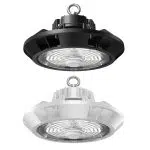
100 / 120 / 150 / 200 Watt Adjustable High Bay
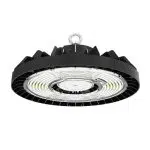
150 / 175 / 200 / 240 Watt Adjustable LED UFO High Bay
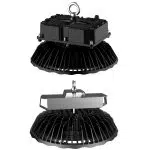
300 Watt UFO High Bay | 45000 Lumens
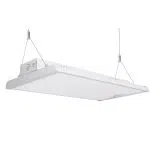
80 / 90 / 105 Watt Adjustable Linear LED High Bay
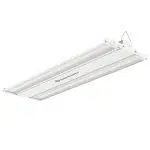
180/240/300 Watt Adjustable LED Indirect High Bay
How LED Lighting Supply Guides You to the Perfect Warehouse High Bay Solution
Our Product Specialists understand that every warehouse faces unique challenges. Drawing from thousands of successful installations, we prioritize four essential factors that determine project success:
- Ceiling height analysis to determine optimal fixture type and spacing patterns
- Required foot-candle levels for different operational zones, typically ranging from 10-50 FC
- Fixture selection between a UFO high bay and Linear high bay configurations
- Advanced operational requirements, including motion sensors, dimming capabilities, and emergency backup systems
Professional Ceiling Height Analysis: Matching LED Solutions to Your Space
LED Lighting Supply's expertise ensures proper illumination through documented installation results and professional lighting designs delivered across diverse warehouse environments.
Low Bay Applications (10-20 Feet): Maximizing Coverage in Compact Spaces
- Optimal Lumen Output: 8,000 to 15,000 lumens per fixture
- Beam Angle Configuration: 120° for comprehensive wide coverage
- Professional Spacing: 12 to 15 feet on center
- Recommended Solutions: Linear high bays or low-profile UFO configurations
- Ideal Applications: Small warehouses, fulfillment areas, retail storage operations
Medium Bay Applications (20-30 Feet): Balanced Performance for Standard Operations
- Optimal Lumen Output: 20,000–30,000 lumens per fixture
- Beam Angle Configuration: 90° to 120° for focused distribution
- Professional Spacing: 15 to 19 feet on center
- Recommended Solutions: UFO high bays or high-output linear systems
- Ideal Applications: Manufacturing floors, larger storage zones, distribution centers
High Bay Applications (30+ Feet): Industrial-Grade Performance
- Optimal Lumen Output: 30,000+ lumens per fixture
- Beam Angle Configuration: 60° to 90° for precise focused coverage
- Professional Spacing: 19 to 40 feet on center
- Recommended Solutions: High-output UFO systems with narrow optics
- Ideal Applications: Aircraft hangars, industrial warehouses, large logistics centers

UFO vs. Linear High Bays: Strategic Selection for Optimal Results
UFO High Bay Lights: Engineered for Metal Halide Replacement and Open Space Illumination
- Design Profile: Compact, circular, downlight-style configuration
- Power Range: 60W–600W with output up to 96,000 lumens
- Key Advantages:
- High lumen density optimization for tall ceiling applications
- IP65+ and IK-rated durability for demanding industrial environments
- Simplified installation with hook or pendant mounting systems
- Professional Recommendation: Our specialists recommend UFO configurations for ceiling heights of 20 to 65 feet based on proven performance data.
Linear High Bay Lights: Designed for Fluorescent Replacement and Aisle Illumination
- Design Profile: Extended rectangular format for uniform light distribution
- Power Range: 80W–500W with output up to 76,900 lumens
- Key Advantages:
- Superior coverage for narrow aisles and racking systems
- Versatile mounting options, including chain, pendant, or surface installation
- Exceptional uniformity across large operational areas
- Professional Recommendation: We engineer solutions using linear high bays for ceiling heights 15 to 40 feet, particularly effective in warehouses with structured racking layouts.
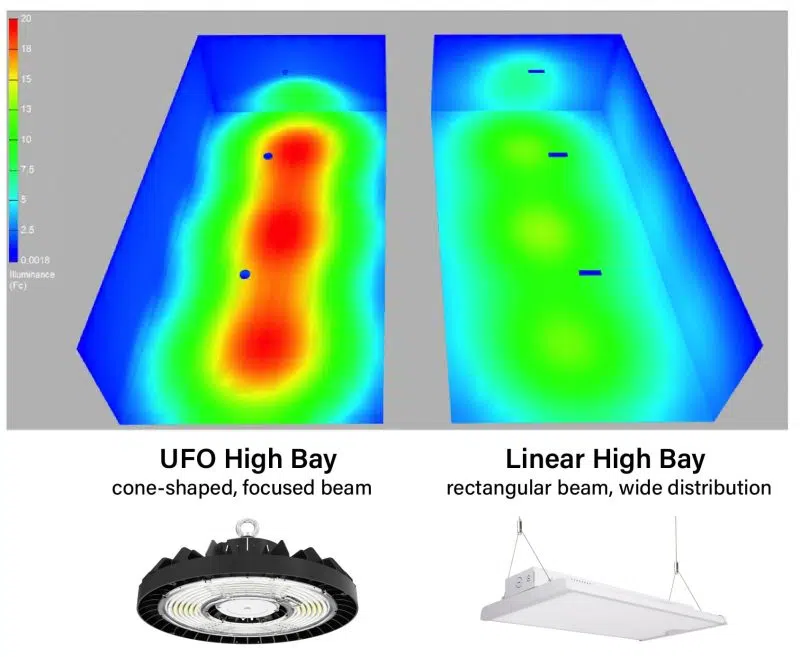
Professional Lumen Calculation Methods: Industry-Standard Illumination Planning
Our Product Specialists understand optimal illumination requirements through ANSI and IESNA standards, combined with photometric modeling techniques refined through thousands of successful installations.
Professional Foot-Candle Guidelines for Warehouse Operations
- General warehouse storage areas: 10-20 foot-candles
- Active picking and packing zones: 30-50 foot-candles
- Quality inspection and control areas: 50-75 foot-candles
- Loading dock operations: 20-30 foot-candles
- Warehouse aisle navigation: 15-25 foot-candles
Professional Calculation Formula: Required Lumens = (Target FC × Square Footage) ÷ Light Loss Factor (0.7-0.8)
Use Our Professional Indoor Fixture Count Lighting Calculator
Proven HID to LED Conversion Guidelines: Data from 15+ Years of Installations
- Replace 250W Metal Halide - 60-100W LED delivering 9,000-15,000 lumens
- Replace 400W Metal Halide - 50-200W LED delivering 18,000-25,000 lumens
- Replace 1000W Metal Halide - 300-400W LED delivering 40,000-55,000 lumens
- Replace 4-tube T5HO Fluorescent - 80-120W Linear LED delivering 10,000-15,000 lumens
- Replace 6-tube T5HO Fluorescent - 120-200W Linear LED delivering 15,000-25,000 lumens

Advanced Features That Maximize Warehouse Operational Efficiency
Our customers frequently tell us that modern commercial-grade LED systems deliver performance advantages far beyond basic illumination. LED Lighting Supply's expertise ensures you benefit from these operational efficiency features.
Professional-Grade Voltage and Adjustable Performance Features
- Voltage Compatibility
- Standard Commercial Systems: 120-277V with automatic driver adjustment
- Industrial Applications: 277-480V supporting single-phase and three-phase configurations
- Advanced Driver Technology: Constant current drivers maintaining power factor >0.95
- Field-Adjustable Wattage Systems
- Toggle switch technology provides field-adjustable power settings, allowing operational optimization without fixture replacement. Our customers frequently tell us this feature enables fine-tuning illumination levels based on actual operational requirements.
- Common Configuration Ranges: 100W/150W/200W or 200W/250W/300W
- Color Temperature Selection and Adjustable Options
- 3000K Warm White: Retail environments and customer-facing warehouse areas
- 4000K Neutral White: General commercial applications and fluorescent replacement projects
- 5000K Bright White: Industrial warehouses, metal halide replacement, and precision work areas
- Onboard toggle switch systems on select models enable post-installation color temperature adjustments
- Professional Beam Angle Adjustment (UFO Models)
- Rotating lens systems providing 60°/90°/120° field adjustment capabilities with no tools required
- Optimize light distribution patterns based on mounting height and spacing requirements for maximum coverage efficiency

Our customers frequently tell us this adjustable high bay fixture delivers exceptional versatility for warehouse installations, featuring both wattage and color temperature adjustment capabilities.
120 / 150 / 200 Watt Adjustable UFO High Bay | 19800 to 33000 Lumens | 4000K / 5000K | 100-277V
Professional Performance Specifications
- 120W Configuration: 19,800 lumens
- 150W Configuration: 24,750 lumens
- 200W Configuration: 33,000 lumens
Smart Control Integration for Enhanced Warehouse Efficiency
- Advanced Motion Sensor Technology:
- PIR Sensors for open warehouse spaces
- Microwave Sensors optimized for dusty or dynamic operational environments
- Professional Detection Range: 15–25 feet coverage
- Dimming Compatibility: 0–10V, 1–10V supporting 10% to 100% adjustment
- Emergency Battery Backup Systems:
- Integrated and external battery pack options
- 90-minute runtime compliance
- 10W–40W emergency output configurations
- OSHA-compliant egress lighting solutions
Professional Insight: Our Product Specialists understand that motion sensors deliver exceptional performance with LED technology. You can program dimmed operational levels during unoccupied periods or complete shutoff capabilities. LED technology doesn't degrade from frequent cycling, unlike traditional lighting. Maximum energy savings result from fixtures operating at shutoff or dimmed to 10% capacity during inactive periods.

Professional Light Quality and Distribution Standards
- Color Rendering Index (CRI): 70+ standard performance for general warehouse operations
- Flicker-Free Operation: Eliminates visual fatigue for comfortable work environments with no humming from outdated ballast systems
- Instant Performance: 100% light output immediately, compared to 15-minute warm-up requirements for metal halide systems
- Cold Weather Performance: Maintains full brightness in cold storage environments, unlike fluorescent systems requiring warm-up periods
Professional Insight: 70 CRI provides adequate color rendering for standard warehouse operations. Higher CRI ratings become necessary for detailed inspection work or processes requiring precise color recognition.

Industrial-Grade Environmental Durability for Demanding Warehouse Conditions
- IP Ratings for Moisture Protection (UFO Models Only)
- IP65: Dust-tight with water jet resistance for standard warehouse applications
- IP66: Dust-tight with powerful water jet resistance for wash-down warehouse areas
- IP69K: High-pressure and high-temperature wash resistance for food distribution centers
- IK Impact Resistance Ratings (UFO Models Only)
- IK08: 5 Joule impact resistance for standard warehouse operations
- IK10: 20 Joule impact resistance for high-impact industrial environments
Professional Recommendation: We've found that facilities requiring moisture protection or high impact resistance achieve optimal results with UFO fixture configurations.
Professional Certifications and Industry Compliance Standards
- UL / ETL Listed: Electrical safety compliance for commercial and industrial facilities
- DLC Certified: Utility rebate program eligibility
- FCC Compliant: Electromagnetic interference prevention standards
- RoHS Compliant: Environmental safety and material standards
Comprehensive Warranty Support and Professional Service
LED Lighting Supply provides comprehensive 5-year warranty coverage on all warehouse high bay systems, with complete warranty support managed by our USA-based team. Our Product Specialists understand the critical importance of maintaining operational lighting systems and work efficiently to resolve any warranty concerns.
Professional Commitment: We handle all warranty claims directly through our experienced support team. You work directly with LED Lighting Supply throughout the entire warranty process, not third-party service providers.
Professional Mounting and Installation Options
- UFO High Bay Mounting Systems
- Eye Hook Configuration: Quick installation with adjustable cable systems
- Pendant Mount Systems: Rigid stem mounting for stable long-term installations
- Linear High Bay Mounting Systems
- Chain and Wire Suspension: Standard mounting for most warehouse applications
- Pendant Mount Systems: Rigid mounting for stable operational installations
- Surface Mount Options: Direct ceiling attachment where clearance is critical

Warehouse LED High Bay ROI Analysis: Documented Financial Impact and Measurable Savings
150W LED vs 400W Metal Halide Replacement Analysis
Based on 16 hours daily operation, 365 days annually at $0.15/kWh electrical rate
Metal Halide System (460W including ballast consumption)
Annual Operating Cost: $402.96 | 5-Year Total Cost: $2,014.80
LED UFO Fixture System (150W)
Annual Operating Cost: $131.40 | 5-Year Total Cost: $657.00 | 5-Year Energy Savings: $1,357.80
Single Fixture Annual Savings: $271.56 | 50 Fixture Annual Savings: $13,578 | ROI Timeline: Under 5 months
Energy Consumption Reduction: 67% | 5-Year ROI: 307% | Operational Life: 50,000+ hours (LED) vs 15,000 hours (Metal Halide)
300W LED vs 1000W Metal Halide Replacement Analysis
Based on 16 hours daily operation, 365 days annually at $0.15/kWh electrical rate
Metal Halide System (1150W including ballast consumption)
Annual Operating Cost: $1,007.40 | 5-Year Total Cost: $5,037.00
LED UFO Fixture System (300W)
Annual Operating Cost: $262.80 | 5-Year Total Cost: $1,314.00 | 5-Year Energy Savings: $3,723.00
Single Fixture Annual Savings: $744.60 | 50 Fixture Annual Savings: $37,230 | ROI Timeline: Under 7 months
Energy Consumption Reduction: 74% | 5-Year ROI: 383% | Operational Life: 50,000+ hours (LED) vs 15,000 hours (Metal Halide)

This Rhode Island warehouse facility upgraded with our 200 Watt UFO fixtures, achieving energy savings exceeding 50% compared to their previous metal halide system.
Professional Warehouse Lighting Design Process: Determining Optimal Fixture Requirements
LED Lighting Supply's Professional Calculation Methodology
Comprehensive Space Analysis: We measure total square footage, ceiling height variations, and identify distinct lighting zones throughout your facility.
Operational Assessment: Our Product Specialists determine foot-candle requirements for storage areas versus active work zones.
Photometric Calculation: We utilize professional lighting software, including AGI32, for precise fixture placement, average foot-candle determination, and lighting uniformity analysis.
Professional Guidelines for Initial Planning
- Standard warehouse operations typically require: 20-30 lumens per square foot
- High-activity operational areas require: 40-50 lumens per square foot
- Professional spacing varies by ceiling height: 12-35 feet on center
Professional Service: LED Lighting Supply provides comprehensive, complimentary lighting plans for all warehouse projects. With over 15 years of experience creating thousands of lighting plans, we provide detailed photometric analysis so you can evaluate lighting performance before making your investment.
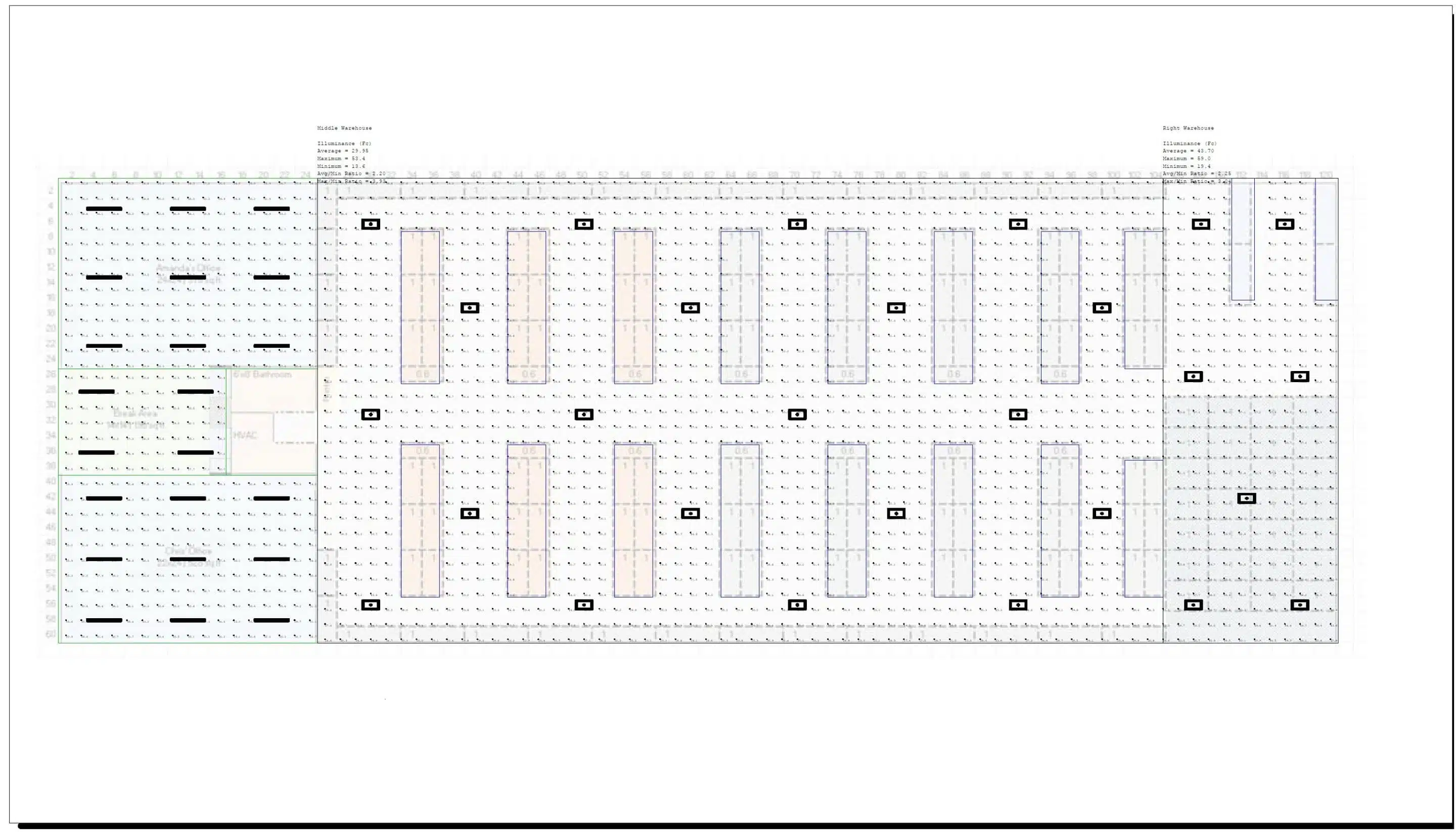
Why LED Lighting Supply Delivers Superior Warehouse High Bay Lighting Solutions
Proven Warehouse Lighting Expertise and Customer Success
- 15+ Years: Dedicated commercial and industrial high bay lighting specialization
- 5,000+ Successful Installations: Documented performance across diverse commercial and industrial applications
- Exceptional Customer Satisfaction: Proven track record across all project types with outstanding customer reviews
- Professional Lighting Engineers: Our certified lighting design team provides complimentary photometric reports for every warehouse project
Ready to transform your warehouse lighting operations with professional LED high bay solutions? Request a quote from our warehouse lighting specialists for a complimentary consultation and professional photometric design. Our certified lighting engineers will create a custom solution that maximizes energy savings, improves operational safety, and delivers measurable ROI for your warehouse facility.
Get Expert Guidance for Your Warehouse Lighting Conversion
Our experienced Product Specialists provide precise energy savings calculations tailored to your specific warehouse facility and current electrical costs. These detailed calculations show your exact annual savings, ROI timeline, and payback period based on your operational hours and utility rates. Our team also creates complementary, custom lighting plans using professional AGI32 software that show exact fixture placement, foot-candle levels, and uniformity ratios for your specific facility dimensions and requirements. With 15+ years of warehouse lighting expertise, our specialists understand the unique challenges of different ceiling heights, racking configurations, and operational zones to recommend the optimal fixture selection and spacing for maximum performance and cost savings.
LED Lights for Commercial Warehouses Frequently Asked Questions
What Type of LED High Bay Light Is Best for Warehouse Applications?
UFO high bays work best for open warehouse spaces with 20-65 foot ceilings, while linear high bays excel in facilities with structured racking systems and ceiling heights of 15-40 feet. UFO fixtures deliver concentrated downlight with lumen outputs up to 96,000 lumens and feature IP65+ ratings for harsh environments. Linear fixtures provide superior aisle coverage and uniform distribution across large areas, making them ideal for fluorescent replacement projects.
How Many Lumens Do I Need per Square Foot in a Warehouse?
Standard warehouse storage areas require 20-30 lumens per square foot, while active picking and packing zones need 40-50 lumens per square foot. Quality inspection areas typically require 50-75 foot-candles of illumination. We calculate total fixture requirements using the formula: Required Lumens = (Target FC × Square Footage) ÷ Light Loss Factor (0.7-0.8).
What Wattage LED Replaces 400W Metal Halide in Warehouses?
A 150W LED high bay delivers equivalent illumination to a 400W metal halide system while providing 67% energy reduction. LED fixtures produce 18,000-25,000 lumens compared to metal halide's degraded output over time. This replacement saves $271 annually per fixture based on 16-hour daily operation at $0.15/kWh, with ROI achieved in under 5 months.
How High Can You Mount LED High Bay Lights in Warehouses?
UFO high bay lights perform effectively at mounting heights up to 65 feet when equipped with narrow 60-degree optics and high lumen output. For ceiling heights above 40 feet, fixtures require minimum 30,000+ lumens with focused beam angles to maintain adequate foot-candle levels. Professional spacing increases to 25-40 feet on center for optimal coverage at extreme heights.
Should Warehouse LED High Bays Have Motion Sensors?
Motion sensors deliver exceptional energy savings in warehouses with intermittent occupancy, reducing consumption by an additional 30-50% beyond LED conversion savings. PIR sensors work best in open warehouse spaces, while microwave sensors perform better in dusty environments. LED technology handles frequent on/off cycling without degradation, unlike traditional lighting systems that suffer from reduced lifespan.
What Color Temperature Is Best for Warehouse Lighting?
5000K bright white provides optimal visibility for industrial warehouse operations and metal halide replacement projects, delivering crisp illumination that enhances safety and productivity. 4000K neutral white works well for general commercial applications and fluorescent replacements. We recommend maintaining 70+ CRI for standard warehouse operations, with higher CRI ratings necessary for detailed inspection work.
How Do I Calculate ROI for Warehouse LED Conversion?
Calculate annual energy savings by comparing current fixture wattage (including ballast consumption) to LED wattage, multiplied by operational hours and electricity rate. A typical 400W metal halide (460W total) replaced with 150W LED saves $271 annually per fixture at $0.15/kWh with 16-hour daily operation. Add maintenance savings from LED's 50,000+ hour lifespan compared to metal halide's 15,000 hours for complete ROI analysis.
What Spacing Is Required Between Warehouse High Bay Fixtures?
Fixture spacing depends on mounting height and beam angle configuration. Low bay applications (10-20 feet) require 12-15 feet spacing with 120-degree optics, while high bay installations (30+ feet) use 19-40 feet spacing with narrow 60-90 degree beam angles. Professional photometric analysis ensures uniform coverage and eliminates dark spots between fixtures.
Do LED High Bays Work in Cold Storage Warehouses?
LED high bay lights maintain 100% light output immediately in cold storage environments, unlike fluorescent systems that require warm-up periods and suffer reduced performance. IP65+ rated UFO fixtures provide moisture protection for refrigerated facilities, while advanced driver technology operates reliably in temperatures down to -40°F. Cold weather operation actually extends LED lifespan compared to standard temperature environments.
Why Choose LED Lighting Supply for Warehouse High Bay Projects?
We combine 15+ years of commercial and industrial lighting expertise with 25,000+ completed projects to deliver optimal warehouse solutions. Our certified lighting engineers provide complimentary photometric analysis using professional AGI32 software, showing exact fixture placement and foot-candle levels for your facility. We handle all warranty support directly through our USA-based team, ensuring reliable service throughout your fixture's 5-year warranty period.
What Professional Services Does LED Lighting Supply Provide for Warehouse Projects?
Our Product Specialists create detailed energy savings calculations specific to your facility's operational hours and utility rates, showing exact annual savings and ROI timelines. We provide comprehensive lighting designs using professional photometric software that account for ceiling height variations, racking configurations, and operational zones. Our consultative approach ensures proper fixture selection, optimal spacing, and integration of advanced features like motion sensors and emergency backup systems for maximum performance and cost savings.

























